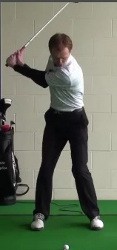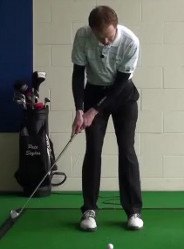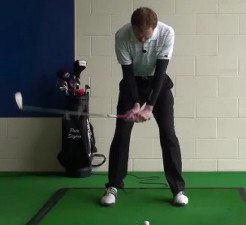
While you can learn a lot by watching the world’s greatest golfers do their thing, the pros have a handful of habits that amateur golfers are wise to avoid.
These quirks mostly stem from the fact that professionals play golf for money. Lots and lots of money. Therefore, spending a few extra seconds or minutes to pull off a perfect shot makes sense for them. For the non-professional, though, such actions mainly slow down play without delivering the desired results.
Because of the money at stake and their competitive personalities, pros can be awfully serious on the course. You’re probably pretty serious at work, too – and for the pros, playing golf is work. (We should all be so lucky.) Adopting their demeanor isn’t necessarily the best way to maximize your performance – or endear yourself to playing partners, for that matter.
You’ll often see Tour pros (like Tiger Woods) rehearsing swing mechanics before and after shots, especially when they’re in the middle of a complex change or honing a specific move. Practicing like this on course may help groove your swing; then again, you could get too caught up in technique — and suffer unexpected consequences.
Why It’s Important
 Many pros are meticulous in the extreme. Jack Nicklaus, for example, is widely cited as the golfer who (inadvertently) taught amateurs to stalk each putt as though the Masters were on the line. For him, it was. For you, not so much.
Many pros are meticulous in the extreme. Jack Nicklaus, for example, is widely cited as the golfer who (inadvertently) taught amateurs to stalk each putt as though the Masters were on the line. For him, it was. For you, not so much.
This is not to suggest that amateurs should ignore variables like wind direction, subtle breaks in the green or exact yardage to the flagstick, or that intense focus is for pros only. On the contrary, playing your best requires attention to detail and steady concentration. But it shouldn’t take very long to gather and process the info that can actually help you.
By the time a player reaches the professional ranks, he’s competed at the highest levels of junior and collegiate golf for years. His mind is conditioned to analyze lots of data for each shot, then make a swing or stroke that integrates the information. Few amateurs have such experience, so an info overload often causes “paralysis by analysis.” The result: An excessively mechanical action that fails to produce good golf shots.
Who (and What) You Shouldn’t Watch

According to their peers and independent analysis, the slowest golfers on the PGA Tour include Kevin Na, Ben Crane, Sergio Garcia, J.B. Holmes, Jonathan Byrd, and Charlie Wi. Once it’s their turn to play, they’ll take up to 40 seconds to hit the ball after starting their pre-shot routine, and even longer when putting. (That doesn’t count time spent preparing while their partners play.)
Tour pros are notorious for crunching yardage figures down to fractions, waiting until the wind is just right before hitting, reading putts from every conceivable angle, taking multiple practice swings, and standing over the ball for a seeming eternity. It obviously works for them, but most amateurs fare better by keeping things simple – and not overthinking.
Similarly, adopting pro-style “game face” – and a matching businesslike attitude – can plant the seeds of frustration. Approaching every hole like you’re competing for a million bucks is bound to trigger disappointment when you hit a poor shot or miss a makeable putt. The resulting negative emotions can hamper you even further.
By all means, give 100 percent on every shot. Set high expectations for yourself. But if you really want to play your best, never forget golf is a game – not a job.
Apply It to Your Game
The amount of info needed for each shot varies based on the golfer’s skill.
Very good players aim for specific targets, such as the flagstick or a side of the fairway, so precise distance and a good feel for the wind’s influence are critical. Higher handicappers typically shoot to hit the fairway or green; for them, minute details are overkill.
Determine what data you need for basic shots based on your level of play. If yardage to the green will suffice, calculate it and proceed. If your shots tend to fly short and/or low, the wind will have a negligible effect, so tossing up handfuls of grass is rather pointless. In short, don’t spend precious time gathering info that’s of no use.
Likewise, there are two appropriate times for working on your swing: During practice, and while waiting for others in your group to play their shots. Taking multiple practice swings before each stroke slows down the game, and often leaves you wondering why your rehearsal swing is better than the real thing.
When it comes to golf, there are certain things that you should avoid doing to improve your performance. Here is a golf tip highlighting some common “what not to do” mistakes and how to avoid them:
- Grip Too Tight: Avoid gripping the club too tightly. A tight grip can restrict your swing and lead to tension in your hands, arms, and body. Instead, maintain a relaxed grip, allowing for a more fluid and natural swing. Focus on holding the club with just enough pressure to maintain control.
- Rush Your Swing: One of the most common mistakes is rushing the swing. Avoid the temptation to swing too quickly or forcefully. Take your time, establish a consistent pre-shot routine, and maintain a smooth tempo throughout your swing. A controlled and rhythmic swing often leads to better results.
- Neglecting Proper Alignment: Alignment is crucial in golf, yet it is often overlooked. Avoid neglecting your alignment and aim. Take the time to align your body, feet, hips, and shoulders parallel to the target line. Use alignment aids such as clubs or targets to help guide your setup. Proper alignment sets the foundation for a more accurate shot.
- Overcomplicating Your Swing Thoughts: It's easy to get overwhelmed with multiple swing thoughts. Avoid overcomplicating your swing by focusing on too many technical details. Instead, simplify your thoughts and focus on one or two key swing fundamentals that work for you. This helps to maintain a clear mind and promotes a more fluid and natural swing.
- Ignoring Course Management: Course management involves making smart decisions based on the layout, hazards, and your own abilities. Avoid blindly attacking pins or taking unnecessary risks. Instead, assess the situation, consider the best strategy, and play to your strengths. Sometimes it's better to take a conservative approach to minimize errors and maximize your chances for success.
- Neglecting Practice on Short Game: Many golfers focus primarily on driving and long shots while neglecting their short game. Avoid this mistake by dedicating ample time to practice your chipping, pitching, and putting. A strong short game can save you strokes and make a significant difference in your overall score.
Remember, golf is a game of patience, practice, and continuous improvement. By avoiding these common mistakes, you can enhance your performance and enjoy a more consistent and enjoyable golfing experience.
Finally, learn to relax between shots. Trying to maintain a high intensity level for 18 holes will wear you out mentally and can cause negative emotional outbursts. Plus, stress leads to tension, the most insidious swing killer of them all.





